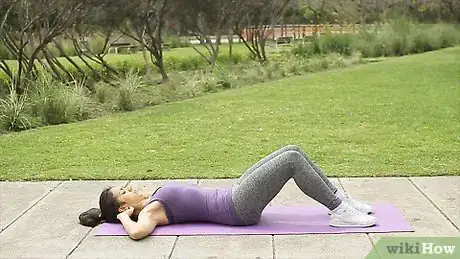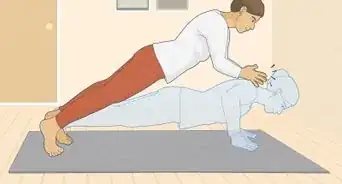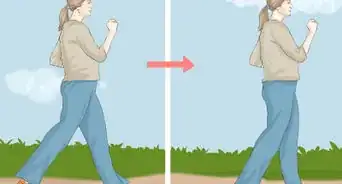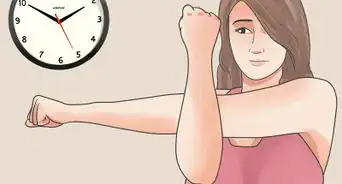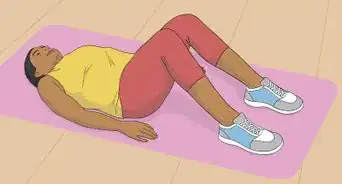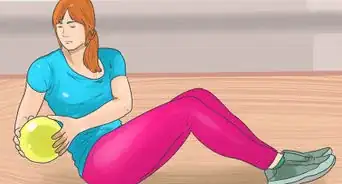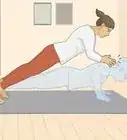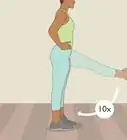This article was co-authored by Tiffany Stafford, CPT and by wikiHow staff writer, Kyle Hall. Tiffany Stafford is a Certified Personal Trainer, Holistic Nutritionist, and the Owner of LifeBODY Fitness, a personal training and small group training studio based in Hillsboro, Oregon. She has over 15 years of personal training and coaching experience. She specializes in wellness training, life coaching, and holistic nutrition teaching. She earned her personal training certification from the National Academy of Sports Medicine (NASM).
There are 10 references cited in this article, which can be found at the bottom of the page.
wikiHow marks an article as reader-approved once it receives enough positive feedback. This article received 13 testimonials and 84% of readers who voted found it helpful, earning it our reader-approved status.
This article has been viewed 3,731,538 times.
Sit ups are an excellent core muscle exercise that target your abdominal muscles, hip flexors, and lower back. When done slowly and carefully, sit ups will not cause back pain, and instead can aid digestion, build muscle, and improve posture over time. Read on for tips to help you conquer the sit up, learn core-crushing variations, and add sit ups into your regular exercise routine.
Steps
Learning the Basics
-
1Start by lying on your back with your knees bent. Sit ups work best if you do them on a soft surface, such as a mattress. Keep your knees bent at a 90-degree angle, with your feet flat on the floor.[1]
- You may be more comfortable if you lie on an exercise mat while you’re doing sit ups.
-
2Put your fingertips on the back of your ears. Your elbows should be bent and pointing out at your sides. Cupping the back of your ears with your fingertips — as opposed to placing them on the back of your head — can help prevent you from pulling yourself up by your neck as you’re doing sit ups.[2]
- You can also cross your arms over your chest or hold your arms slightly above the floor so they’re parallel to your sides.
Advertisement -
3Lift your torso up as close to your thighs as possible. Do this with a smooth, steady motion, keeping your feet flat on the floor. When you’re done lifting your torso, your lower back should be off the floor.[3]
-
4Lower your torso down to the floor so you’re back in the starting position. Like you did when you lifted your torso up to your thighs, use a smooth and steady motion as you lower it down.[4]
- Once you’re back in the starting position, you can repeat the exercise if you want to do more reps.
-
5Do 3 sets of 10-15 reps. Give your body a minute or so to rest in between sets. If you feel yourself struggling to keep good form, do fewer sit ups until you get stronger.
- If you're having trouble doing 3 sets, start with 2 sets until you're able to do more sit ups.
- For a more intense workout, try a different exercise to reach deeper muscles in your abdomen, such as the dead bug or plank.
-
6Do sit ups 2-3 times a week. For the best results, you'll want to avoid doing sit ups every day. Your muscles grow the most when they're recovering, so it's important that you give your abs a day off in between workouts.[5]
- For example, you could do sit ups on Mondays, Wednesdays, and Fridays, and then not do any ab exercises on the days in between.
-
7Pair sit ups with other abdominal exercises for a better workout. Doing a variety of abdominal exercises is a good way to work out both your upper and lower abs, and it keeps your body working to adapt, which is good for muscle growth. Once you've gotten the hang of sit ups, try other ab exercises like:[6]
- Crunches
- Flutter kicks
- Leg raises
- Planks
Doing Sit Up Variations
-
1Try doing weighted sit ups. To do a weighted sit up, lie on your back with your knees bent, just like you would for a regular sit up. Then, hold a dumbbell or barbell weight against your chest by crossing your arms over it. Lift your torso up to your thighs and then lower yourself back down to the floor.[7]
- Start out with light weights and gradually increase the amount of weight you’re holding as you get better at doing weighted sit ups.
- Remember to keep your feet flat on the floor.
-
2Do some twisted sit ups. To do twisted sit ups, start in the same position as you would for a regular sit up, with your knees bent and your fingers placed behind your ears. Then, lift your torso up toward your thighs and twist it to the right until your left elbow is touching your right knee. Lower yourself down to the starting position and repeat.[8]
- Alternate twisting your torso to the left and to the right.
-
3Give jack knife sit ups a try. To do jack knife sit ups, lie on your back with your knees bent and your feet lifted 4–5 inches (10–13 cm) off the floor. Extend your arms so they’re straight above your head. When you’re ready, bring your arms and knees together while flexing your abdominal muscles.[9]
- After you bring your arms and knees together, lower them back into the starting position and repeat.
- Make sure you're keeping your arms straight as you bring them toward your knees.
Avoiding Common Mistakes
-
1Avoid pulling yourself up with your neck. When you’re doing sit ups, it’s easy to get in the habit of using your neck to pull your torso up to your thighs. Unfortunately, doing this can strain your neck and increase your risk of injury. Make sure you’re using your abs to lift yourself up while doing sit ups.[10]
- If you feel neck strain, stop the exercise. Fix your head posture. If it persists, you may have stretched or weak neck muscles.
-
2Don’t drop your torso to the floor when you’re finishing a sit up. When you drop your torso to the floor, you’re preventing your abdominal muscles from getting a full workout. Just like when you’re going up at the beginning of a sit up, you want to use a slow, controlled motion to lower your torso back down to the floor.[11]
- If you feel like your back is hitting the floor when you lower your torso, it may be a sign that you’re doing your sit ups too quickly.
-
3Avoid weighing your feet down while you're doing sit ups. While weighing your feet down may make doing sit ups seem easier, it actually does more harm than good. Weighing down your feet causes you to use your hip flexors more, which can strain your body and cause back pain.[12]
- Instead of weighing down your feet, focus on keeping your feet flat on the ground while you're doing sit ups.
Expert Q&A
Did you know you can get premium answers for this article?
Unlock premium answers by supporting wikiHow
-
QuestionIs it normal to feel pain during sit-ups?
 Michele DolanMichele Dolan is a BCRPA certified Personal Trainer in British Columbia. She has been a personal trainer and fitness instructor since 2002.
Michele DolanMichele Dolan is a BCRPA certified Personal Trainer in British Columbia. She has been a personal trainer and fitness instructor since 2002.
Certified Fitness Trainer
-
QuestionHow do you do a proper sit-up?
 Michele DolanMichele Dolan is a BCRPA certified Personal Trainer in British Columbia. She has been a personal trainer and fitness instructor since 2002.
Michele DolanMichele Dolan is a BCRPA certified Personal Trainer in British Columbia. She has been a personal trainer and fitness instructor since 2002.
Certified Fitness Trainer
-
QuestionI can't lift the bottom area of my back when doing sit-ups. What can I do to improve?
 Michele DolanMichele Dolan is a BCRPA certified Personal Trainer in British Columbia. She has been a personal trainer and fitness instructor since 2002.
Michele DolanMichele Dolan is a BCRPA certified Personal Trainer in British Columbia. She has been a personal trainer and fitness instructor since 2002.
Certified Fitness Trainer
Warnings
- Sit ups can cause neck strain and lower spine injuries. Some safer and more effective abdominal exercises include planks, dead bugs, mountain climbers, leg lifts, and crunches.⧼thumbs_response⧽
References
- ↑ https://www.mensfitness.com/weight-loss/burn-fat-fast/situp
- ↑ https://www.muscleandfitness.com/workouts/abs-and-core-exercises/videos/situp
- ↑ https://www.mensfitness.com/weight-loss/burn-fat-fast/situp
- ↑ https://www.mensfitness.com/weight-loss/burn-fat-fast/situp
- ↑ https://www.mensfitness.com/training/pro-tips/trainer-qa-how-often-should-i-train-my-abs
- ↑ https://www.mensfitness.com/training/pro-tips/trainer-qa-how-often-should-i-train-my-abs
- ↑ https://www.muscleandfitness.com/workouts/abs-and-core-exercises/videos/weighted-situp
- ↑ https://www.royalnavy.mod.uk/careers/joining/get-fit-to-join/advice-and-guidance/exercises/gym/sit-up-twist
- ↑ https://www.youtube.com/watch?time_continue=1&v=CWOZyf8kaH0&feature=emb_logo
- ↑ https://www.youtube.com/watch?v=jDwoBqPH0jk&feature=youtu.be&t=24
- ↑ https://www.youtube.com/watch?v=jDwoBqPH0jk&feature=youtu.be&t=41
- ↑ https://www.youtube.com/watch?v=Q-mK2nVl0Ek&feature=youtu.be&t=22
- ↑ Tiffany Stafford, CPT. Personal Trainer. Expert Interview. 26 March 2020.
About This Article
To do a sit up, start by lying on your back and bending your knees so your feet are flat on the floor. Then, place your fingertips behind your ears, or cross your arms over your chest. You can place your hands wherever feels most natural, but make sure you aren't pulling up on your neck when you exercise. Once you're in position, lift your torso up to your thighs as much as you can, while keeping your core tight. It's ok if you're only lifting off of the ground slightly when you first start out! Go as far as you can, then slowly lower your torso back to the floor. As you're doing the exercise, you should feel a burn in your abdominal muscles. However, if you experience pain in your neck or back, stop and readjust.
